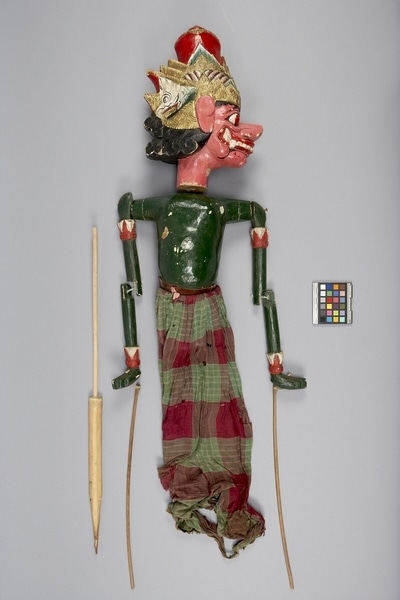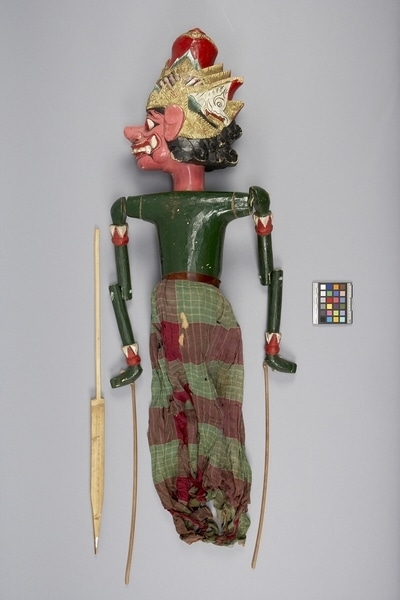Rod Puppet Item Number: Ib359 from the MOA: University of British Columbia


Description
A three-dimensional male humanoid figure puppet. Has a large head, and jointed arms attached to controlling rods. The pink face is positioned forward with bulging eyes that have red irises, a wedge-shaped nose, and red lips with a prominent upper row of white teeth, and having overlapping fangs at each side of the mouth. Large red crown (mahkota) headdress with multi-tiered diadem (jamang), karawista, sumping, Garuda Mungkur (short-tongue), and badong, deep fringe of hair in red, gold, black, green, and white. Large seam at the rear of the crown. Corpulent torso with large belly, and prominent dark green chest. . Hands are held flat, and bending back at the wrists. Wearing a green, and purple plaid skirt with a leather waistband.
History Of Use
Javanese puppetry as an art form probably developed by the 11th century. Wayang golek puppets of western Java appeared during the 16th century. Originally the plays depicted Javanese mythology, but after the Indian conquest of Java the Hindu epics, Ramayana and Mahabharata, were incorporated into the cycles, which comprise about 200 plays. A dalang (puppet master) performs the plays to celebrate important occasions, usually in three acts, with vocal and instrumental accompaniment. Typically they serve a moral and religious purpose, and more recently, one of political commentary. In the Mahabharata cycle, Arimba is persuaded to side with the Kurawa brothers in their unjust usurpation of the kingdom of the Pandawa brothers.
Cultural Context
Theatrical performance.
Iconographic Meaning
Each puppet is characterized by it's wanda, a Javanese word which describes the specific mixture of elements of size, form, colour, ornamentation and carving. Colour, position of face, eyes suggest aggressiveness, irreverence. Large size and corpulence, as well as fangs are considered less than refined and kasar (evil); these features identify puppet as a ogre or rakshasa. Plaid skirt implies low rank; crown indicates that puppet is a king. Identified as Arimba, a prabu (king) found in plays based on the Mahabharata cycle of legends.
Item History
- Made in Java, Indonesia
- Owned by Tradewind Antiques before March 15, 1983
- Received from Museum of Anthropology Shop Volunteers (Funding source) and Tradewind Antiques (Seller) on March 15, 1983
What
Who
- Culture
- Sundanese
- Previous Owner
- Tradewind Antiques
- Received from
- Museum of Anthropology Shop Volunteers (Funding source) and Tradewind Antiques (Seller)
Where
- Holding Institution
- MOA: University of British Columbia
- Made in
- Java, Indonesia
When
- Ownership Date
- before March 15, 1983
- Acquisition Date
- on March 15, 1983
Other
- Condition
- poor
- Accession Number
- 0886/0093